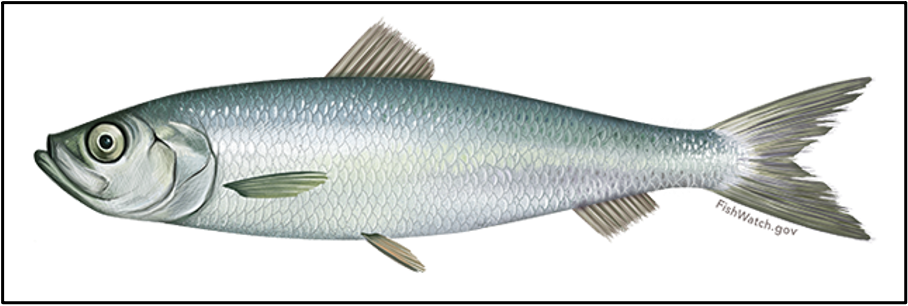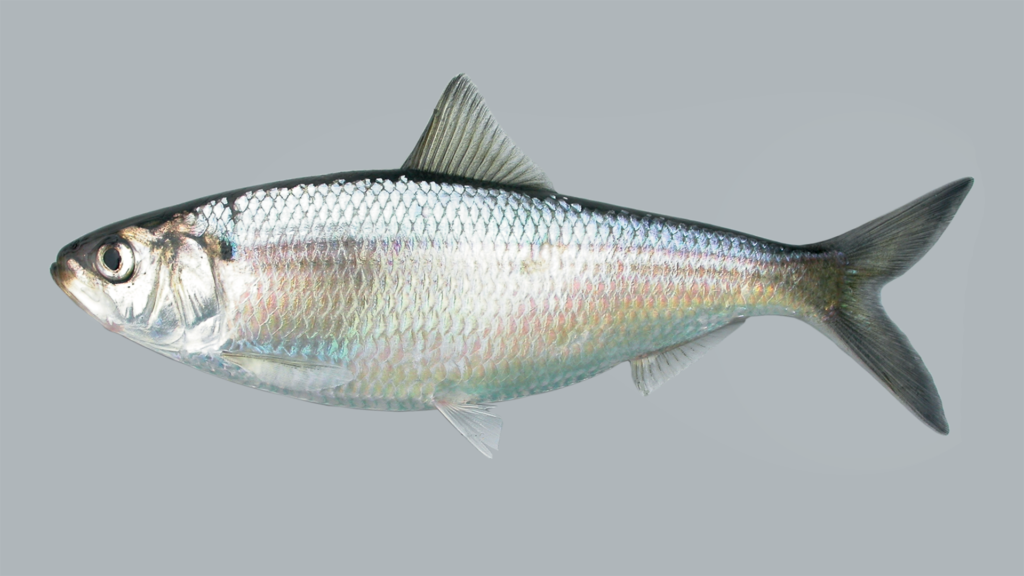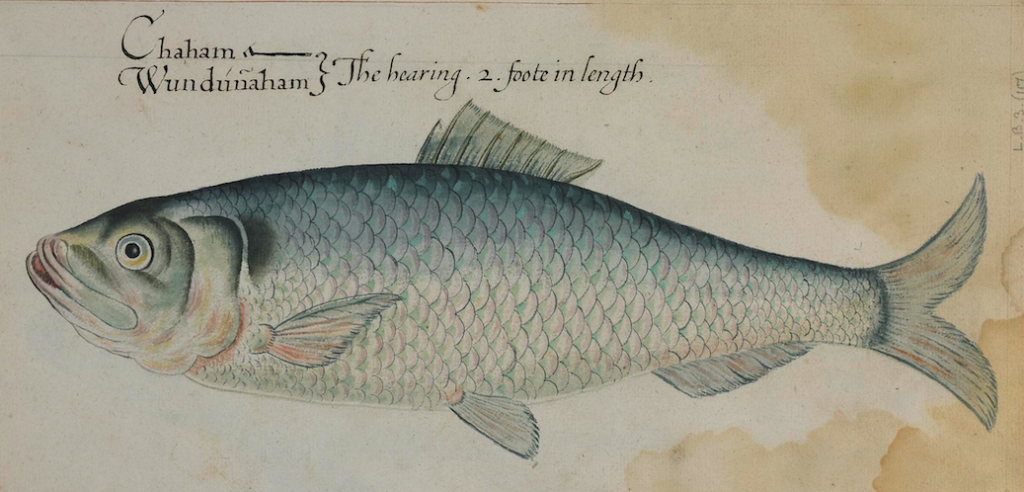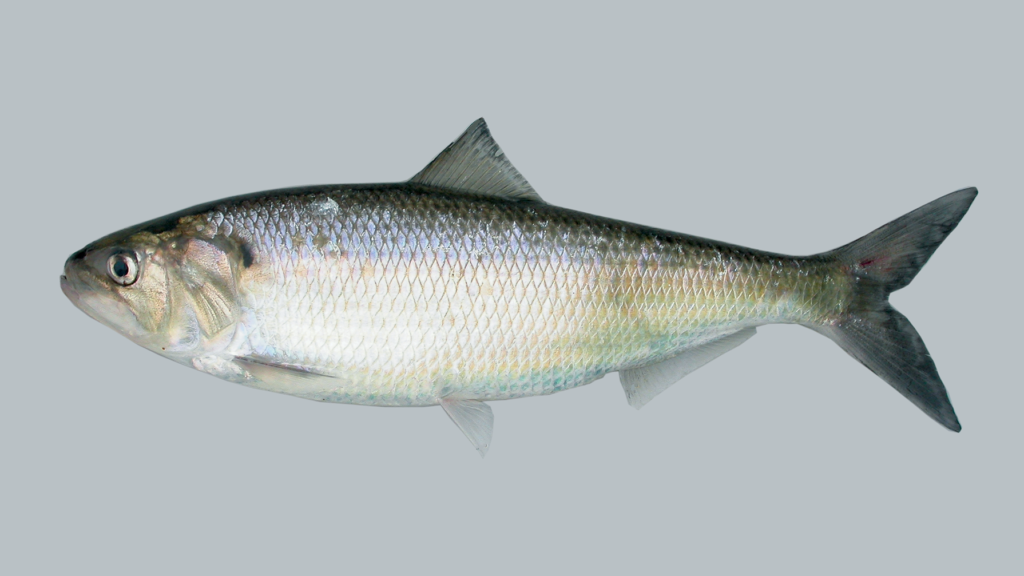By the NCFishes.com Team
(Written by Bryn. H. Tracy)
This blog post is an update to Scott A. Smith’s original blog posting on Shad Identification, dated June 16, 2015. All links to the original post now redirect here.
I grew up with this children’s poem, “Wynken, Blynken, and Nod”, written by Eugene Field (1850-1895, published 1889), as have my two daughters and now my grandson. I often visited Eugene Field’s house, now a historical site, growing up in St. Louis, MO and memorized his poem at an early age. Only many, many years later would I realize that there are actually herring fish that live in the deep blue sea and other places, and I am still able to recite this poem:
“Wynken, Blynken, and Nod one night sailed off in a wooden shoe, sailed on a river of crystal light into a sea of dew. “Where are you going, and what do you wish?” The old moon asked the three. “We have come to fish for the herring-fish that live in this beautiful sea; nets of silver and gold have we,” said Wynken, Blynken, and Nod.
The old moon laughed and sang a song, as they rocked in the wooden shoe; and the wind that sped them all night long ruffled the waves of dew. The little stars were the herring-fish that lived in the beautiful sea. Now cast your nets wherever you wish, never afraid are we!” so cried the stars to the fishermen three, Wynken, Blynken, and Nod.
All night long their nets they threw to the stars in the twinkling foam, – Then down from the skies came the wooden shoe, bringing the fishermen home: ‘Twas all so pretty a sail, it seemed as if it could not be; and some folk thought ’twas a dream they’d dreamed of sailing that beautiful sea; but I shall name you the fishermen three: Wynken, Blynken, and Nod.
Wynken and Blynken are two little eyes, and Nod is a little head, and the wooden shoe that sailed the skies is a wee one’s trundle-bed. So shut your eyes while Mother sings of wonderful sights that be, and you shall see the beautiful things as you rock in the misty sea, where the old shoe rocked the fishermen three: – Wynken, Blynken, and Nod.”

To my wonder later on, I learned that North Carolina is home to 13 species of herrings (Table 1). But you may know only the more common ones such as American Shad, Hickory Shad, Alewife, Blueback Herring, Atlantic Menhaden, Gizzard Shad, and Threadfin Shad. Few people, except for perhaps some fishermen along the coast, have ever heard of or seen Round Herring, Yellowfin Menhaden, Atlantic Herring, Scaled Sardine, Atlantic Thread Herring, or Spanish Sardine.
Table 1. Species of herrings found in or along the coast of North Carolina.| Scientific Name/ American Fisheries Society Accepted Common Name | Scientific Name/ American Fisheries Society Accepted Common Name |
|---|---|
| Alosa aestivalis, Blueback Herring | Dorosoma cepedianum, Gizzard Shad |
| Alosa mediocris, Hickory Shad | Dorosoma petenense, Threadfin Shad |
| Alosa pseudoharengus, Alewife | Etrumeus sadina, Round Herring1 |
| Alosa sapidissima, American Shad | Harengula jaguana, Scaled Sardine |
| Brevoortia tyrannus, Atlantic Menhaden | Opisthonema oglinum, Atlantic Thread Herring |
| Brevoortia smithi, Yellowfin Menhaden | Sardinella aurita, Spanish Sardine |
| Clupea harengus, Atlantic Herring |
1 Until recently, Round Herring, Etrumeus sadina (previously known as E. teres), was placed, along with all the other clupeids found in North Carolina, in the Family Clupeidae. Fish taxonomists now place this species in the Family Dussumieriidae.
Alewife and Blueback Herring are often referred to as “River Herring”; other colorful names applied to this family of fishes include glut herring, bigeye herring, nanny shad, stink shad, or just plain “shad”. As we have learned, each species has its own scientific (Latin) name which actually means something (please refer to The Meanings of the Scientific Names of Herring, pages 16 and 17) along with an American Fisheries Society-accepted common name (Page et al. 2013).

Herring occur across the state in freshwater and saltwater environments, but especially in many of our reservoirs, coastal rivers, estuaries, and offshore (Tracy et al. 2020; NCFishes.com [Please note: Tracy et al. (2020) may be downloaded for free at: https://trace.tennessee.edu/sfcproceedings/vol1/iss60/1.] Most species are found along the coast (Maps 1-13), but Gizzard Shad is our most widely distributed species found in all basins, except for the New, Watauga, and Savannah (Map 6). [Note: see Supplemental Maps 1-3 , page 19, showing North Carolina’s 100 counties, 21 river basins, and 4 physiographic regions.]
Able to convert phytoplankton and zooplankton into fish biomass and as important prey species for commercially and recreationally important piscivorous species such as Striped Bass and Largemouth Bass, Gizzard Shad and Threadfin Shad have been stocked in many reservoirs across the state as forage fish. Threadfin Shad, a nonindigenous (nonnative) species was stocked, at times illegally, as a forage fish in many of Piedmont reservoirs in the Roanoke, Yadkin, Catawba, Broad, Savannah, Little Tennessee, and Hiwassee basins. Over time it has found its way downstream to the coast and is now widely distributed from the Albemarle to the Shallotte basins. Alewife, indigenous to our Atlantic Slope streams, was illegally introduced into Lake Norman as wishfully new forage fish for the Striped Bass and Largemouth Bass fishery. Like most poorly thought-out introductions, Alewife and Blueback Herring have caused more harm than good to the fisheries in reservoirs such as lakes James, Norman, and Hiwassee.
As a family, herrings vary greatly in size. On the short-end-of-the-stick, Threadfin Shad and Scaled Sardine reach a maximum size of about 180 mm (~ 7 inches) whereas a mature American Shad may reach close to 760 mm (30 inches). Because of their size and abundance, herring were historically and remain today a commercially and recreationally important group of fishes with seasonal and river-basin specific creel and landing limits (e.g., NCDMF 2020; NCWRC 2019, 2020). John White illustrated Alewife [although it could possibly be a Blueback Herring or American Shad] labeled with the Algonquin word used by the Croatoan First Peoples for Alewife, Chaham (https://www.coastalcarolinaindians.com/updated-algonquian-word-list-by-scott-dawson/), and noted: “The hearing. 2. foote in length” (Figure 1).

Figure 1. Painting of Alewife by John White, 1585-1593. Painting courtesy of the British Museum, Museum No. SL,5270.100 (https://www.britishmuseum.org/collection/object/P_SL-5270-100).
More than a century after John White painted Alewife, herrings and shads were mentioned as occurring in North Carolina’s waters by John Lawson in 1709 who described them as: “Shads are sweet Fish, but very bony; they are plentiful at some Seasons”(Lawson(1709), p157).He went on to write: “The Herrings in Carolina are not so large as in Europe. They spawn there in March and April, running up the fresh Rivers and small fresh Runs of Water in great Shoals, where they are taken. They become red if salted; and, drest [dressed] with Vinegar and Oil, resemble an Anchovy very much; for they are far beyond an English Herring, when pickled” (Lawson (1709), p 158).
Species of Alosa, except for land-locked reservoir populations, make late Winter-early Spring migratory spawning runs up the coastal rivers. Historically the runs occurred far upstream into the Piedmont until dam construction along the Fall Zone and over-fishing halted their migrations. Implementation of strict harvesting quotas has helped some of the species on their road to recovery, but recovery may take a long time to succeed. Although some populations are severely depleted, no species is listed as imperiled (NCNHP 2018; NCWRC 2017).

The identification of herrings is relatively straight-forward. Key characteristics for their proper identification include the shape and position of the upper jaw; presence or absence of a long filament in the dorsal fin; body, caudal fin, and peritoneum pigmentation (please refer to the Identification Key to the Species of Herrings (Family Clupeidae and Dussumieriidae) in North Carolina. However, several species can co-occur within the same habitats at the same time, rendering field identifications a challenge.
If you have troubles with your identifications, just send us (fishesofNC@gmail.com) an e-mail and include as many quality digital photographs as you can along with all the pertinent locality descriptors so that we will know from where the fish came.
And now you know who Wynken, Blynken, and Nod are.